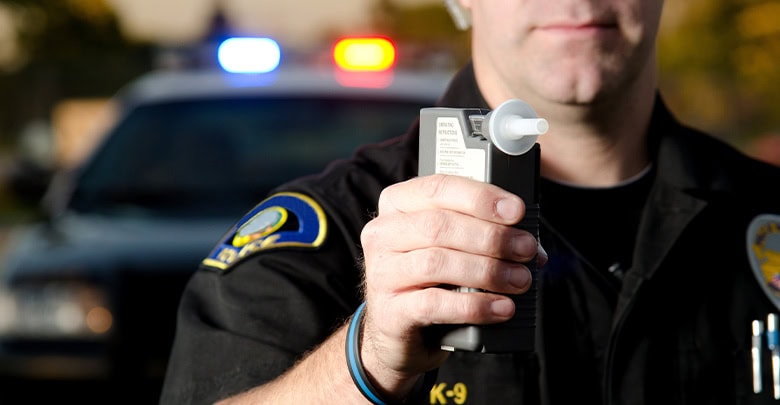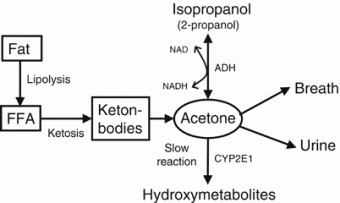Ketones Role in False Positives on Breath Alcohol Tests
Low carb diets and ketones from hyperglycemia can both lead to false positives from common roadside breathalyzer technology

Alcohol is a complicated subject when it comes to type 1 and type 2 diabetes — especially for those who take insulin and other medications capable of causing hypoglycemia.
While low blood sugar has been known to be mistaken for drunkenness, diet or diabetes-related ketones may mistakenly trigger a false positive on a breath alcohol test.
A study published by the International Journal of Obesity found evidence that ketones can potentially result in a false positive on a breath alcohol test — something especially important for people with diabetes and anyone following a ketogenic diet.
How Breath-Alcohol Tests Work
“These tests are used by police to indirectly measure how much alcohol is in a person’s blood,” explains the National Institute on Drug Abuse for Teens.
“Alcohol breath-testing devices use the amount of alcohol in exhaled breath to calculate the amount of alcohol in a person’s blood, also known as blood alcohol concentration (BAC).”
When you consume alcohol, it enters your stomach and small intestine and is very quickly absorbed into your bloodstream. Your BAC reaches its highest level about one hour after consuming alcohol, but some of it will show up in a breath alcohol test within minutes of drinking.
Your liver is responsible for breaking down about 90 percent of the alcohol you drink, because like other toxins, your liver wants to clear the poisonous substance from your system as quickly as possible. (This priority to remove toxins is also why it can interfere with the digestion of food and cause delayed hypoglycemia.)
The rest of the alcohol is eliminated through both your urine and your breath.
The breath-testing device used most commonly in traffic stops converts the amount of alcohol detected in your breath to a corresponding blood alcohol level.
It is illegal to drive a car if your BAC is over 0.08 percent. (And of course, for those under 21, driving with any alcohol detected on your breath is illegal because it’s illegal for you to drink in the first place.)
Different factors can affect the rate at which alcohol impacts your breath alcohol content include: your weight, gender, time since your last meal, history of drinking, and how much you’ve consumed within any given period of time.
False Positives in Breath Alcohol Tests from Keto Diets
“A 59-year-old man undergoing weight loss with ‘very-low-calorie diets’ (VLCD) attempted to drive a car, which was fitted with an alcohol ignition interlock device, but the vehicle failed to start,” explains the study.
The driver of the vehicle was surprised by the test results because he was 100 percent sober.
VLCD in research usually consists of approximately 800 calories per day and very few carbohydrates.
“After a few days of dieting, fat becomes the main source of energy, and VLCD regimens are consequently ketogenic.”
When following a strict low-carb diet, your body burns body fat differently in a way that results in ketones, resulting in “ketonemia,” which is defined simply by a high presence of ketones in the bloodstream.
Along with ketones, ketonemia also includes high levels of acetone, acetoacetate, and β-hydroxybutyrate.
The breath alcohol testing device measures other types of alcohol beyond alcohol.
“The interlock device determines alcohol (ethanol) in breath by electrochemical oxidation, but acetone does not undergo oxidation with this detector,” explains the study. “However, under certain circumstances, acetone is reduced in the body to isopropanol by hepatic alcohol dehydrogenase (ADH). The ignition interlock device responds to other alcohols (e.g. methanol, n-propanol, and isopropanol), which therefore explains the false-positive result.”
The science here is a bit overwhelming, but the nutshell version is this: one component of a ketone is acetone and the acetone can be metabolized into “hepatic alcohol dehydrogenase” or ADH, which could then result in a false positive on a breathalyzer test.
“Acetone is a water-soluble volatile product of metabolism and is therefore exhaled in the breath and excreted in the urine,” explains the study.

In fact, measuring a person’s breath is one way a study or medical protocol can be sure a patient is following their VLCD.
“The elimination half-life of acetone in humans is fairly long,” adds the study, meaning that ketones can persist in your breath up to 15 to 25 hours.
“During ketonemia, the reduction pathway toward isopropanol becomes a strong possibility and, indeed, this secondary alcohol has been identified in blood tests of patients with hyperglycemia and poorly controlled diabetes.”
“If acetone is reduced to isopropanol during ketonemia, there is a strong possibility of false-positive results when ignition interlocks are used. Indeed, the concentration threshold for a positive test and failure to start the engine is often set fairly low, corresponding to a blood alcohol concentration (BAC) of 0.01–0.02 g/100 ml.”
What happens next?
If you were pulled over and asked to take a breathalyzer test, a false positive due to ketones isn’t the end-all and be-all of your results.
“Suspected drunk drivers first submit to a roadside breath-alcohol screening test and if this is positive they provide either an evidential breath-alcohol test or a blood specimen is taken for laboratory analysis,” explains the study.
“Breath-alcohol screening tests incorporate electrochemical detectors similar to those used in the ignition interlock device and therefore respond to isopropanol. By contrast, most evidential breath-testing is performed by multifilter infrared analysis, and these are programmed to abort the test if acetone is detected on the suspect’s breath above a certain threshold value.”
In other words: it would likely be revealed in the actual blood test results if the only alcohol present in your body at the time was from acetone.
Accurate testing depends on the type of testing equipment used.
“Evidential breath-alcohol analyzers based on electrochemical oxidation cannot distinguish ethanol from isopropanol and this resulted in a false-positive test after VLCD,” adds the study.
This means it’s critical that if you were in the situation of taking a breath alcohol test, and you’re either experiencing diabetes-related ketones as a person with type 1 or following a very low-carb ketogenic diet, you need to inform the officials operating the testing equipment of this potential variable.
“We suggest that people on ketogenic diets run the risk of false-positive breath alcohol tests owing to the reduction of acetone to isopropanol,” concludes the study. “People on VLCD need to be warned about this artifact when alcohol ignition interlock devices are used. This possibility also warrants consideration in connection with workplace alcohol testing and screening of drunk drivers with electrochemical sensors.”
In other words, speak up if you think your ketones may trigger a false positive.